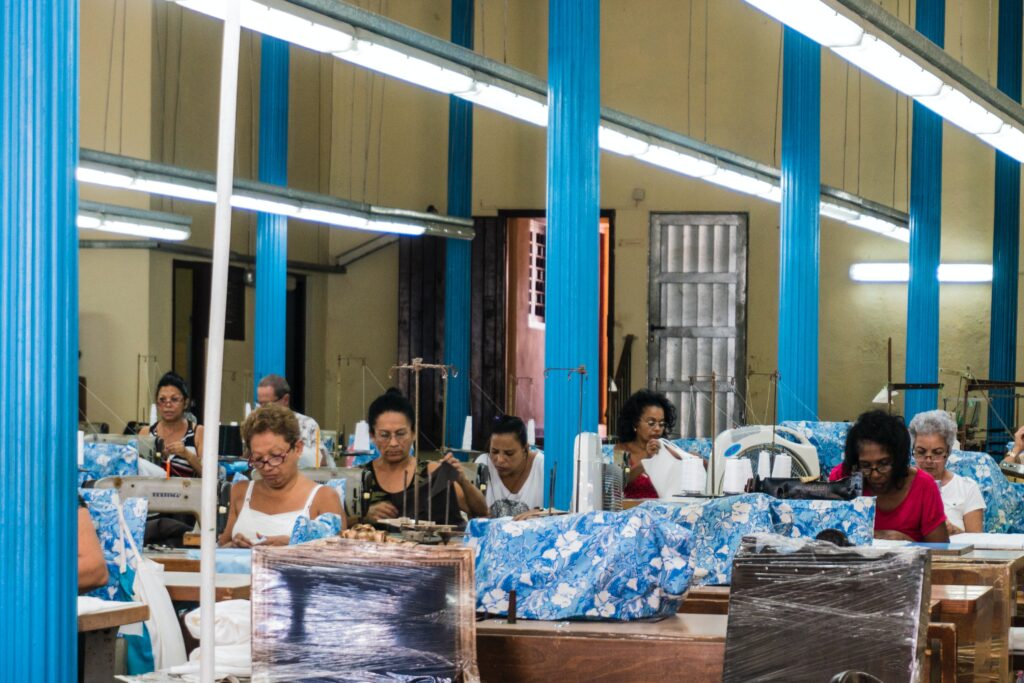
Technological advancements are shifting the ways we imagine the future of sustainability. Some argue that a ‘sustainable fashion industry’ is inherently contradictory – how could promoting overconsumption ever align with sustainability efforts? As we investigate what comes next, a tech-based revamp of the less glamorous side of the industry appears to be inevitable.
A sustainable fashion industry is often brushed off as an oxymoron; impossible to achieve and a marketing tactic by those responsible for its position within the top 3 most polluting industries. The fashion industry is built on promoting consumption and in more recent years promoting overconsumption to the furthest degree.
In 2026, the fast fashion industry is estimated to be worth 133 Billion USD. From a purely profits-based perspective, one could argue this model is “working”. However, if a brand new t-shirt only costs 5$ and for a profit to be made after paying for raw materials, labor, transport, or shipping it means there must be others actually paying the true price for this garment. Sustainability is not only an environmental issue but a human rights and feminist one as well. Of the 60-70 million garment workers worldwide, 75% are women. Although women’s emancipation has been directly linked to the ability to enter the workforce, sweatshop-like conditions are closer to exploitation rather than empowerment. The unregulated nature of the garment industry and major companies outsourcing their production allows them to create a distance between themselves and the exploitation occurring where their clothes are produced.

Many claim the only way for a sustainable fashion industry to become reality, in all senses of the word, is through a global shift in perspective. We have become desensitized to “500$ Shien haul” videos and no longer think twice when cheap clothes fall apart. Our view of fashion and clothes can no longer be tied to the trend cycle. An emphasis on personal style and buying clothes we will love and wear for a long time is a small step we can take as individuals to participate in a sustainable fashion industry. However, this is not enough nor is it particularly exciting. Fashion is important to us because it is fun and provides opportunities for creativity and self-expression. This is where technology can take the lead and revive the industry in an innovative way.
A sustainable fashion industry cannot be achieved with only a few players participating. A common agreement must be reached and upheld, but we are not there yet, and time is running out. According to resources provided by law firm Morrison Foerster, “Sustainability initiatives thus often require joining forces and collaborating to achieve a critical participating mass… including an alignment between companies on certain competitive parameters, such as the use of certain sustainable products or production standards”. It is easy to sidestep responsibility and pass the blame to the European Union’s anti-trust regulations. As a result of these agreements, sustainability collaborations could be in violation of the EU anti-competitive agreements (Art. 101 TFEU) and could have negative consequences on the participating parties. There already have been repercussions for those who signed an open letter in 2020 calling for changes that would make the industry more sustainable.

This stands in the way of those who wish to shift to a more sustainable model – however, it would be naive to believe that this goal permeates the entire industry. Shifting to a sustainable model could mean a cut in profits especially when competitors do not follow and continue to produce low-cost clothing. The former CEO of H&M Karl-Johan Persson has warned against the “terrible” consequences of movements that call to put a stop to consumption. Although the company appears to be taking a new direction by appointing Helena Hemersson, their former director of sustainability, as CEO in 2022.
While the industry giants fail to react quickly enough, technology is coming to the rescue. Reselling platforms are gaining favor, especially in the e-commerce space, while the metaverse is promising a new front for self-expression by dressing our digital avatars, and blockchain technology can be utilized to close the fashion loop and promote transparency.
We cannot eliminate the physical fashion industry; at the end of the day, we still will wear clothes. The second-hand industry is the closest option to our current fashion habits – except it’s better (sort of) and has been slowly gaining acceptance globally. The resale market is expected to grow by 127% by 2026. This growth can be credited to the success of consumer-to-consumer platforms such as theRealReal, ThredUp, Depop, and Vinted to name a few. The successes of these platforms have piqued the interest of major brands looking to expand their revenues. According to ThredUps research “88 percent of retail executives who currently offer resale say it’s helping drive revenue” and that there’s been a 275% increase in brand-owned resale. Boohoo group has announced that starting in 2022 a resale platform will be available for all its brands including Nasty Gal and Pretty Little Thing – two notorious fast fashion brands. Buying second-hand is especially popular for luxury brands as they can be found at more accessible price points and the revival of interest in archive fashion. This poses a concern for luxury brands and their reputation – if they don’t maintain an exclusive price point on the secondhand market it could damage their public perception. The acceptance of reselling and repairing by luxury brands is an attempt to maintain control on the second life cycle of the products. Burberry, for example, does well on the second-hand market, and noticing this they introduced a program focused on repairing items to ensure they last.

ThredUp also states that “technology is the main driver of consumers to shop second hand with 70% stating that it is easier than it was 5 years ago”. E-commerce is a huge driver in this as finding something secondhand on the internet is a few clicks and keywords away. If you walk into a Goodwill and yell out “trench coats” you will be greeted by concerned stares rather than 100s of options in front of you within seconds. Basically, it takes away the time sacrifice that used to be synonymous with shopping secondhand. Furthermore, these apps allow consumers to sell their own clothes which gives an opportunity to create some extra cash with a low time commitment. All the while, preventing pre-loved clothing from going straight into landfill. In 2021, eBay alone saved 18,000 tons of items due to the rise in popularity of shopping secondhand all of which would’ve eventually ended up shipped to landfills across the world in developing nations.
Conversations around the metaverse are buzzing, but we all know the most important question is what will you be wearing in the virtual world? So, many fashion houses and brands are coming to the rescue in the Decentraland which even hosted its own fashion week: #MVFW22. McKinsey estimated that Gen Z and Gen X will be spending up to 5 hours a day in the metaverse within the next 5 years. Unlike London, Paris, or Milan fashion weeks, anyone who wanted was able to attend and shop. For more information on the metaverse and fashion: https://www.ftaccelerator.it/blog/metaverse-luxury-fashion-trends/.

Although it is just the beginning and this may seem a bit odd to us now, dressing your avatar in the metaverse eventually would be a form of self-expression. One of the needs that fashion fulfills. The digital world could allow us to explore and experiment without the constraints of the real world, and of course without the environmental impact of manufacturing, transport, and disposal. This is an example of how a sustainable fashion industry could function in our future – although it would be quite different than we are currently used to. Digital fashion and the metaverse go hand in hand, and while both are just in the early stages, they appear very promising for the future of sustainable fashion with uninhibited creativity and expression.
On the topic of the metaverse and buying/selling NFTs; blockchain technologies are proving useful for transparency and embracing a closed-loop system. In an attempt to combat the climate crisis, the EU commission has introduced the idea of digital product passports which can be stored on the blockchain and can be accessed by all stakeholders to trace and support sustainability initiatives.

The EU stated that these passports would be effective for, “Second life operators to take informed business decisions and allow recyclers to better plan their operations and improve recycling efficiencies”. As we mentioned before, sustainability is also an issue of human rights. Enforcing transparency through digital product passports would make supply chain information public and human rights violations that occur along it more easily identifiable. Digital product passports, similarly, to the metaverse, are still in their infancy. Yet, major drawbacks to using blockchain technology could stunt their growth for two reasons 1) the extensive energy consumption blockchain and NFTs require and 2) sensitive business information being publicly available. These issues are already working towards being addressed, however, at this moment they still appear further off.
It is fair to assume that consumers know that business cannot be run as usual – as the threat of the climate crisis looms the dopamine from buying something new decreases. Still, companies are run by profits – so it is worth mentioning the possible benefits the sustainable label can lend. It has been proven that corporate social responsibility has the potential to increase profits by 20%. If taken seriously, the future of fashion may be promising rather than driving us to extinction. The new technology being applied to sustainability and fashion might just be the antidote to fashion’s dirty past.